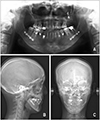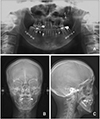1. Figueroa AA, Polley JW, Ko EW. Maxillary distraction for the management of cleft maxillary hypoplasia with a rigid external distraction system. Semin Orthod. 1999; 5:46–51.


2. Ross RB. Treatment variables affecting facial growth in complete unilateral cleft lip and palate. Cleft Palate J. 1987; 24:5–77.

3. Yang CJ, Pan XG, Qian YF, Wang GM. Impact of rapid maxillary expansion in unilateral cleft lip and palate patients after secondary alveolar bone grafting: review and case report. Oral Surg Oral Med Oral Pathol Oral Radiol. 2012; 114:e25–e30.

4. Akcam MO, Evirgen S, Uslu O, Memikoğlu UT. Dental anomalies in individuals with cleft lip and/or palate. Eur J Orthod. 2010; 32:207–213.


5. Schultes G, Gaggl A, Kärcher H. Comparison of periodontal disease in patients with clefts of palate and patients with unilateral clefts of lip, palate, and alveolus. Cleft Palate Craniofac J. 1999; 36:322–327.


6. Rachmiel A, Aizenbud D, Peled M. Long-term results in maxillary deficiency using intraoral devices. Int J Oral Maxillofac Surg. 2005; 34:473–479.


8. Vanarsdall RL, Secchi AG. Periodontal-orthodontics interrelationships. In : Graber TM, Vanarsdall RL, editors. Orthodontics, current principles and techniques. 5th ed. St. Louis: Mosby;2012. p. 807–841.
9. Iannetti G, Cascone P, Saltarel A, Ettaro G. Le Fort I in cleft patients: 20 years' experience. J Craniofac Surg. 2004; 15:662–669.

10. Welch TB. Stability in the correction of dentofacial deformities: a comprehensive review. J Oral Maxillofac Surg. 1989; 47:1142–1149.


11. Figueroa AA, Polley JW. Management of severe cleft maxillary deficiency with distraction osteogenesis: procedures and results. Am J Orthod Dentofacial Orthop. 1999; 115:1–12.


12. Kessler P, Wiltfang J, Schultze-Mosgau S, Hirschfelder U, Neukam FW. Distraction osteogenesis of the maxilla and midface using a subcutaneous device: report of four cases. Br J Oral Maxillofac Surg. 2001; 39:13–21.


13. Mofid MM, Manson PN, Robertson BC, Tufaro AP, Elias JJ, Vander Kolk CA. Craniofacial distraction osteogenesis: a review of 3278 cases. Plast Reconstr Surg. 2001; 108:1103–1114.


14. Figueroa AA, Polley JW, Friede H, Ko EW. Long-term skeletal stability after maxillary advancement with distraction osteogenesis using a rigid external distraction device in cleft maxillary deformities. Plast Reconstr Surg. 2004; 114:1382–1392.


15. Scolozzi P. Distraction osteogenesis in the management of severe maxillary hypoplasia in cleft lip and palate patients. J Craniofac Surg. 2008; 19:1199–1214.


16. Tomita D, Omura S, Ozaki S, Shimazaki K, Fukuyama E, Tohnai I, et al. Maxillary movement in distraction osteogenesis using internal devices in cleft palate patients. Cleft Palate Craniofac J. 2011; 48:161–166.


17. Al-Gunaid T, Asahito T, Yamaki M, Hanada K, Takagi R, Ono K, et al. Relapse tendency in maxillary arch width in unilateral cleft lip and palate patients with different maxillary arch forms. Cleft Palate Craniofac J. 2008; 45:278–283.


18. Johal A, Katsaros C, Kiliaridis S, Leitao P, Rosa M, Sculean A, et al. State of the science on controversial topics: orthodontic therapy and gingival recession (a report of the Angle Society of Europe 2013 meeting). Prog Orthod. 2013; 11:14–16.

19. Bassarelli T, Dalstra M, Melsen B. Changes in clinical crown height as a result of transverse expansion of the maxilla in adults. Eur J Orthod. 2005; 27:121–128.


20. Chua HD, Hägg MB, Cheung LK. Cleft maxillary distraction versus orthognathic surgery-which one is more stable in 5 years? Oral Surg Oral Med Oral Pathol Oral Radiol Endod. 2010; 109:803–814.


21. Saltaji H, Major MP, Altalibi M, Youssef M, Flores-Mir C. Long-term skeletal stability after maxillary advancement with distraction osteogenesis in cleft lip and palate patients. Angle Orthod. 2012; 82:1115–1122.


22. Kumar A, Gabbay JS, Nikjoo R, Heller JB, O'Hara CM, Sisodia M, et al. Improved outcomes in cleft patients with severe maxillary deficiency after Le Fort I internal distraction. Plast Reconstr Surg. 2006; 117:1499–1509.


23. Gulsen A, Ozmen S, Tuncer S, Aslan BI, Kale S, Yavuzer R. Maxillary advancement with internal distraction device in cleft palate patients. J Craniofac Surg. 2007; 18:177–185.

24. Aikawa T, Iida S, Isomura ET, Namikawa M, Matsuoka Y, Yamada C, et al. Breakage of internal maxillary distractor: considerable complication of maxillary distraction osteogenesis. Oral Surg Oral Med Oral Pathol Oral Radiol Endod. 2008; 106:e1–e7.

25. Bevilacqua RG, Ritoli EL, Kang C, Mabry K, Castiglione CL. Midmaxillary internal distraction osteogenesis: ideal surgery for the mature cleft patient. Plast Reconstr Surg. 2008; 121:1768–1778.


26. Nakagawa K, Ueki K, Takatsuka S, Marukawa K, Yamamoto E. A device for determining the position of intraoral distractors for protracting the maxilla. J Craniomaxillofac Surg. 2003; 31:234–237.


27. Lauwers F, Mayorca-Guiliani A, Lopez R, Woisard-Bassols V, Paoli JR, Boutault F. Maxillofacial intraoral distraction osteogenesis followed by elastic traction in cleft maxillary deformity. Int J Oral Maxillofac Surg. 2005; 34:85–88.


28. Van Sickels JE, Madsen MJ, Cunningham LL Jr, Bird D. The use of internal maxillary distraction for maxillary hypoplasia: a preliminary report. J Oral Maxillofac Surg. 2006; 64:1715–1720.














 PDF
PDF ePub
ePub Citation
Citation Print
Print








 XML Download
XML Download